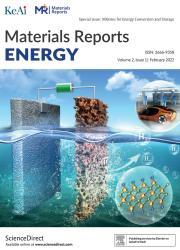高性能燃料电池主/侧链双阳离子聚甲喹嗪-三苯哌啶阴离子交换膜的构建
IF 13.8
引用次数: 0
摘要
阴离子交换膜(AEMs)兼具高氢氧导率和耐碱性稳定性,已成为阴离子交换膜燃料电池(aemfc)长期发展的主要挑战。本研究通过在聚芳基哌啶骨架中引入一定比例的大位阻甲喹嗪(MEQ)分子构建单元,设计了一系列双官能化季铵阳离子聚甲喹嗪-terphenyl哌啶(QPMTP-X) AEMs。QPMTP-X既保留了聚芳基胡椒啶优异的力学性能,又将MEQ所具有的碱性稳定性和高离子电导率与柔性喹核素侧链相结合,实现了膜性能的整体提升。值得注意的是,QPMTP-30表现出高达206.83 mS cm - 1的超高电导率和出色的碱性稳定性(在80°C的2 M NaOH中调理1000小时后,电导率保持在95%以上)。在燃料电池性能测试中,QPMTP-30达到974.5 mW cm - 2的峰值功率密度(PPD),在80°C (0.1 a cm - 2)下稳定工作60小时以上。在聚芳基哌替啶骨架中加入大空间位阻构件和多阳离子,不仅可以协同发展高性能的AEMs,而且为未来的AEMs结构设计开辟了新的思路。本文章由计算机程序翻译,如有差异,请以英文原文为准。

Constructing main/side chain dual-cation poly(mequitazine-terphenyl piperidinium) anion exchange membranes for high-performance fuel cells
Anion exchange membranes (AEMs) combining high hydroxide conductivity and alkali-resistant stability have become a major challenge for the long-term development of anion exchange membrane fuel cells (AEMFCs). Here, we designed a series of poly(mequitazine-terphenyl piperidinium) (QPMTP-X) AEMs with dual-functionalized quaternary ammonium cations by introducing a certain proportion of large steric hindrance mequitazine (MEQ) molecular building unit into the poly(aryl piperidinium) backbone. QPMTP-X retains the excellent mechanical properties of the poly(aryl piperidinium), while also combining the alkaline stability and high ionic conductivity exhibited by MEQ with flexible quinuclidinium side chains, achieving an overall improvement of membrane performance. Notably, QPMTP-30 exhibits an ultra-high conductivity of up to 206.83 mS cm−1 and excellent alkaline stability (over 95% conductivity is maintained after 1000 h of conditioning in 2 M NaOH at 80 °C). In fuel cell performance test, QPMTP-30 achieves a peak power density (PPD) of 974.5 mW cm−2 and operates stably at 80 °C for more than 60 h (0.1 A cm−2). Incorporating large steric hindrance building blocks and multi-cations into the poly(aryl piperidinium) backbone not only synergizes the development of high-performance AEMs but also opens up new ideas for the structural design of future AEMs.
求助全文
通过发布文献求助,成功后即可免费获取论文全文。
去求助
来源期刊

材料导报:能源(英文)
Renewable Energy, Sustainability and the Environment, Nanotechnology
CiteScore
13.00
自引率
0.00%
发文量
0
审稿时长
50 days
 求助内容:
求助内容: 应助结果提醒方式:
应助结果提醒方式:


